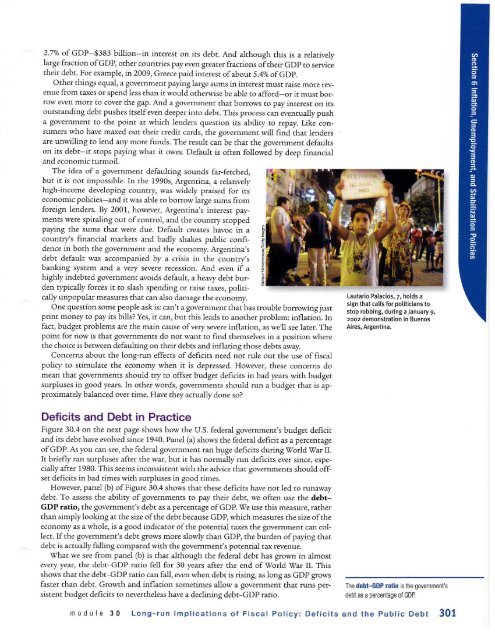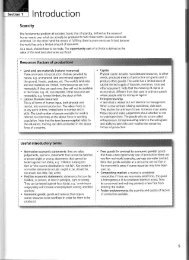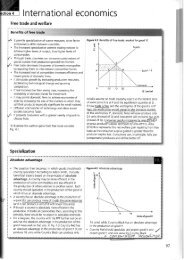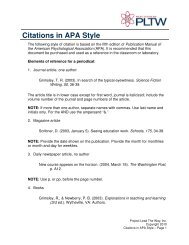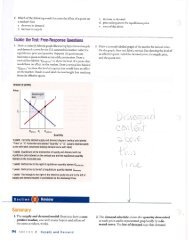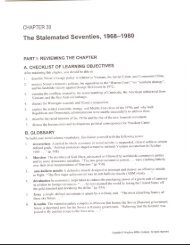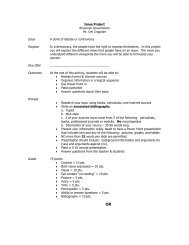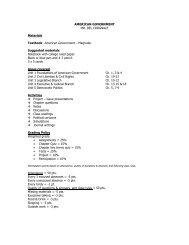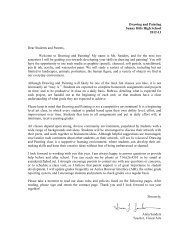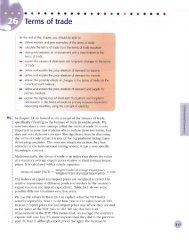AP Econ Module 30 Deficits Debt - Sunny Hills High School
AP Econ Module 30 Deficits Debt - Sunny Hills High School
AP Econ Module 30 Deficits Debt - Sunny Hills High School
You also want an ePaper? Increase the reach of your titles
YUMPU automatically turns print PDFs into web optimized ePapers that Google loves.
2.7yo of GDP-9383 billion-in interest on its debt. And although this is a relatively<br />
large fraction ofGDP, other countries p ay even greater frartions oftheir GDp to service<br />
their debt. For example, in 2009, Greece paid interest ofabout S.4% ofcDp.<br />
Other things equal, a govemment paying Large sums in interest must raise more revenue<br />
from taxes or spend less than it would otherwise be able to afford-or it must borrow<br />
even more to cover the gap. And a government that borrows to pay interesr on irs<br />
outstanding debt pushes itselfeven deeper into debt. This process can evenrually push<br />
a govemment to the point at which lenders question its abfiry to repay. Like consumers<br />
who have maxed out their credit cards, the govemnent will find that lenders<br />
are unwilling to lend any more funds. The result can be thar rhe government defaults<br />
on its debt-it srops pafng what it owes. Default is often followed by deep financial<br />
and economic turmoil.<br />
The idea of a government defaulring sounds far-fetched,<br />
but it is not impossible. In the 1990s, Argentina, a relatively<br />
high-income developing country was widely praised for its<br />
econornic policies-and it was able to borrow large sums from<br />
foreign lenders. By 2001, however, Argentina's interest payments<br />
were spiraling out ofcontrol and the country stopped<br />
paying the sums that were due. Default creates havoc in a<br />
country's financial markets and badly shakes public confidence<br />
in both the government and the economy, Argentina's<br />
debt default was accompaaied by a crisis in the country's<br />
banking system and a very severe recession. And even if a<br />
highly indebted govemment avoids default, a heavy debt burden<br />
typically forces it to slash spending or raise taxes, politically<br />
unpopular measures that can also damage the econorny.<br />
One question some people ask is: can't a govemment that has t(ouble borrowing just<br />
print money to pay irs bills? Yes, it can, but this leads to another problem: inflation. In<br />
fart, budget problems are the main cause ofvery severe inflacion, as we'Il see later. The<br />
point for now is that governments do not want to find themselves in a position where<br />
the choice is between defaulting on their debts and inflating those debts away.<br />
Concerns about the long-run effects of deficits need not rule out the use of fiscal<br />
polici' to stimulate the economy when it is depressed. However, these concems do<br />
mean that governments should try to offset budget deficits in bad years with budget<br />
surpluses in good years. In other words, governments should run a budget that is approxirnately<br />
balanced over time. Have they actually done so?<br />
<strong>Deficits</strong> and <strong>Debt</strong> in Practice<br />
Figure <strong>30</strong>.4 on the next page shows how the U.S. federal govemmenc's budget deficit<br />
and its debt have evolved since 1940. Panel (a) shows the federal deficir as a percentage<br />
of GDP. As you can see, the federal govemment ran huge deficits during World W'ar II.<br />
It briefly ran surpluses after the war, but it has normally run deficits ever since, especially<br />
after 1980. This seems inconsistent with the advice that governments should offset<br />
deficits in bad times with surpluses in good times.<br />
However, panel (b) ofFigure <strong>30</strong>.4 shows that these deficits have not led to runaway<br />
debt. To assess the ability of governments to pay their debr, we often use the debt-<br />
GDP ratio, the governmenCs debt as a percentage ofGDP. W'e use this measure, raaher<br />
than simply looking at the size ofthe debt because GDP, which measures the size ofthe<br />
economy as a whole, is a good indicator oFthe potential taxes the government cal collect.<br />
Ifthe governmenCs debt grows more slowly than GDP, the burden ofpafng that<br />
debt is actua-lly fa-lling compared with the governmenCs porential rax revenue.<br />
What we see from panel (b) is that although the federal debt has grown in almost<br />
eyery year, the debt-cDP ratio fell for <strong>30</strong> years after the end of World War II. This<br />
shows that the debt-GDP ratio can fall, even when debr is rising, as long as GDP grows<br />
faster than debt. Growth and inflation sometimes allow a govemment that runs persistent<br />
budget deficits to nevertheless have a declining debt-GDP rado.<br />
m o d u le 3 0 Long-run lmplications of Fiscal Policy: <strong>Deficits</strong><br />
Lautario Palacios, T, holds a<br />
sign that calls forpotiticlans to<br />
stop robblng, durlng a January 9,<br />
2oo2 demonstlatlon ln Buenos<br />
Aires, Argentina.<br />
fte debt-G0P ratio is he government's<br />
debt as a percentage of GDP,<br />
and the Public Dsbl <strong>30</strong>1


